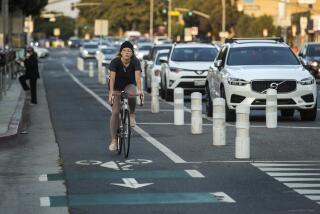In traffic-choked L.A., a car lane is given to bicycles
- Share via
In a city known for traffic gridlock, deliberately eliminating an entire lane for cars could be politically dubious.
But that’s just what officials did Thursday as they unveiled Los Angeles’ newest bicycle lane, a 2.2-mile stretch along 7th Street from Catalina Avenue in Koreatown to Figueroa Street downtown.
“Hold on to your hats, folks, we’re actually removing a lane for a car — in favor of a bike lane — in Los Angeles,” City Councilman Ed Reyes said during a news conference at MacArthur Park. “By doing so, we, as a city, are changing the way we see bicycles, as not only a recreational vehicle but as a legitimate form of public transportation.”
Cycling advocates cheered the news as one of the strongest indications yet that Los Angeles is slowly introducing more paths for those pedaling on two wheels. Officials estimate some 27,000 Angelenos ride a bicycle daily.
“It’s really symbolic,” said Allison Mannos of the Los Angeles County Bicycle Coalition. “It’s not only showing that L.A. is changing overall and becoming more bike-friendly as a city … [but] we’re able to bring [bike lanes] to areas where people are depending on their bikes every day.”
Cyclists are not only middle-class white urbanites who can afford a car but choose to not always drive, but also transit-dependent residents in low-income minority communities such as Westlake, Mannos said.
She said the 7th Street proposal emerged from conversations with laborers who frequently use the thoroughfare to commute.
Transportation officials say the state vehicle code makes it illegal for drivers to use lanes designated for cyclists.
Tim Fremaux, an official with the city’s transportation department, said the new lane is part of the Bike Master Plan adopted this year. He said 7th Street was a prime site because it has relatively low traffic compared with neighboring thoroughfares such as Wilshire Boulevard.
All that was needed for the transformation from car lane to bike lane, Fremaux said, was paint and striping along the road, a few signs and some minor adjustments to traffic lights.
Bike lanes are relatively cheap compared with other transportation infrastructure, costing approximately $50,000 to $100,000 per mile, Fremaux said.
The bike plan calls for more than 200 miles of new routes every five years, but some officials and cycling advocates say there does not appear to be enough funding to reach that goal.
Last weekend, two other bicycle lanes opened: a 1.6-mile stretch on 1st Street from Boyle Avenue to Lorena Street and a 0.6-mile path on Cahuenga Boulevard between Odin and Yucca streets. Fremaux says the next two will probably be in the San Fernando Valley, on Reseda Boulevard and Tuxford Street. Officials also hope to eventually extend the 7th Street lane another 2.9 miles through downtown and into Boyle Heights.
More to Read
Sign up for Essential California
The most important California stories and recommendations in your inbox every morning.
You may occasionally receive promotional content from the Los Angeles Times.












